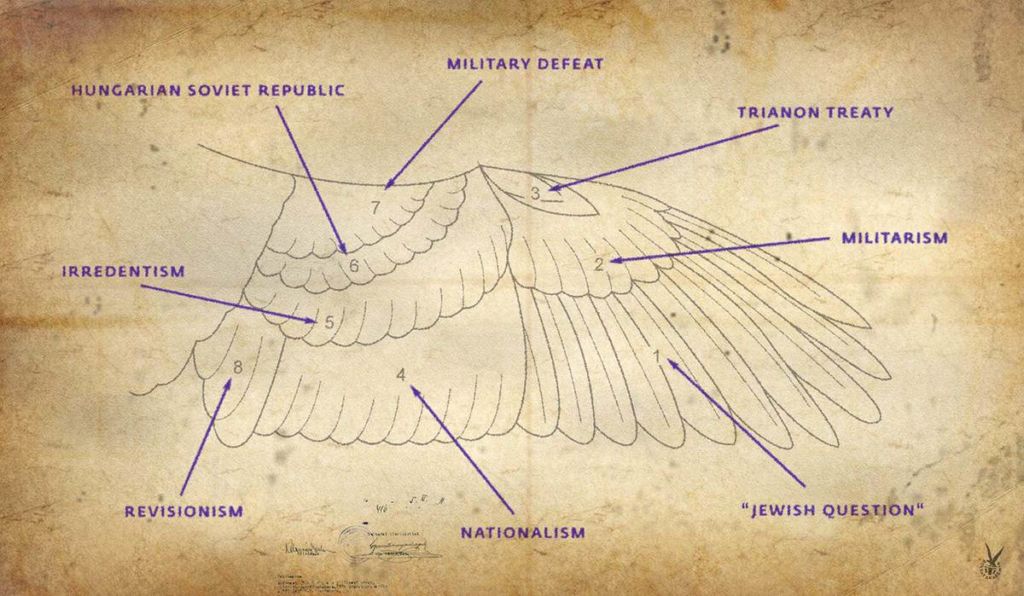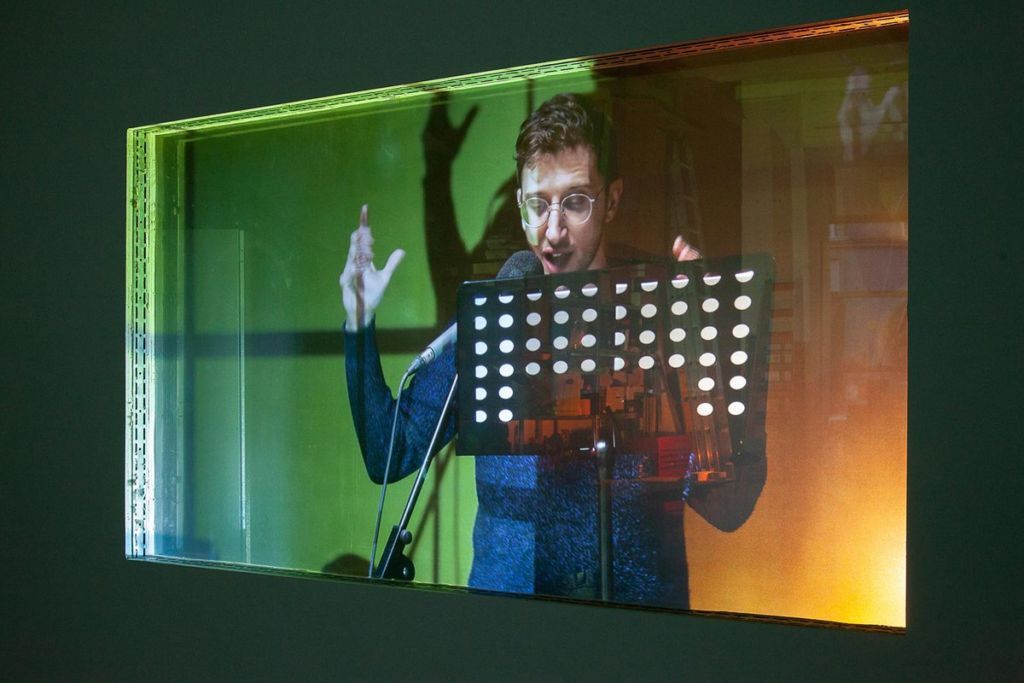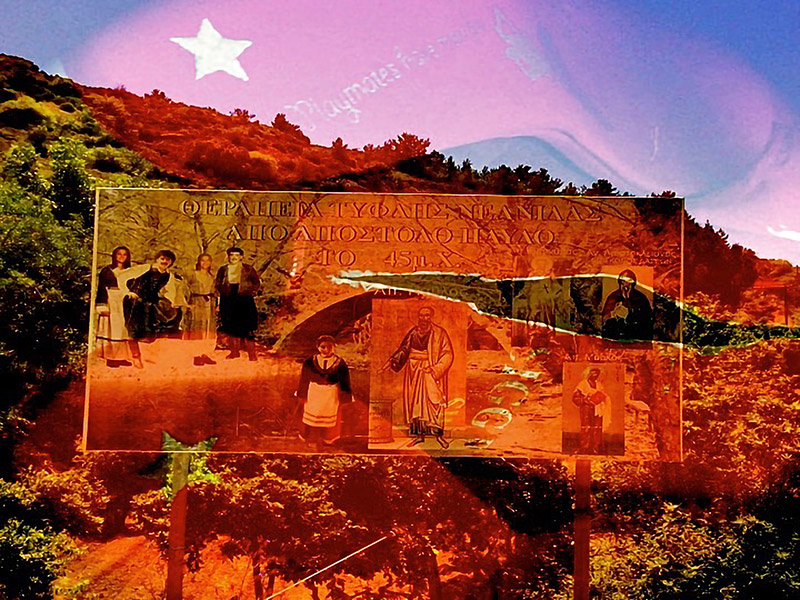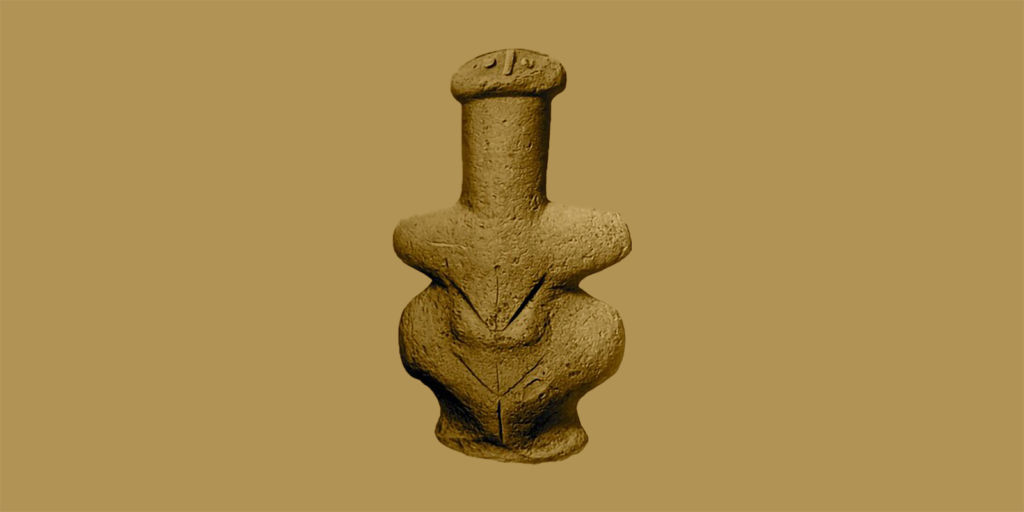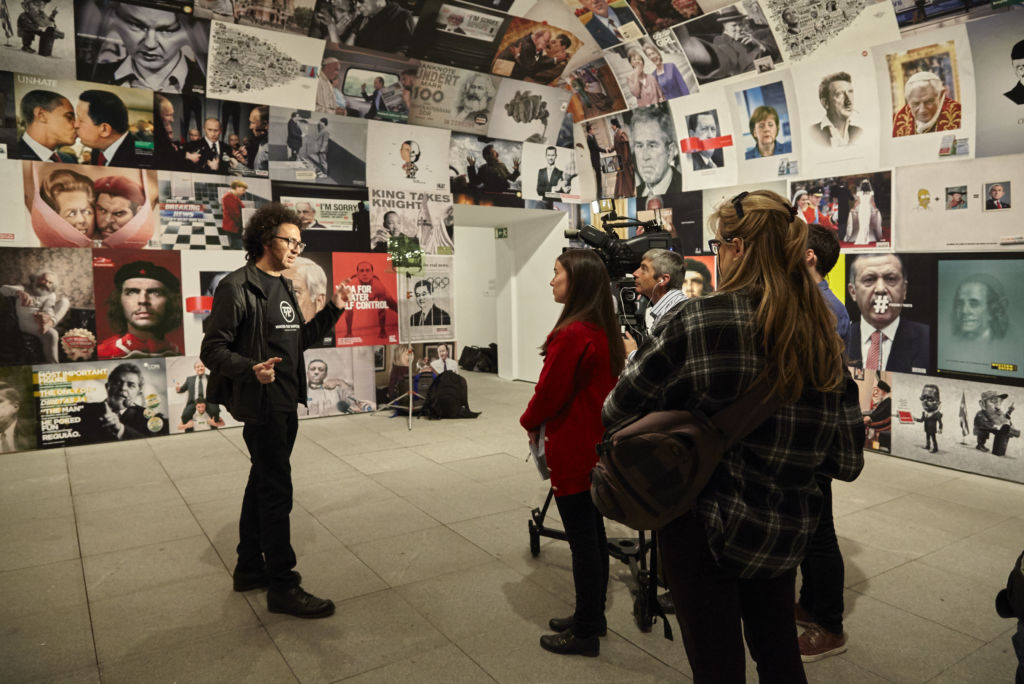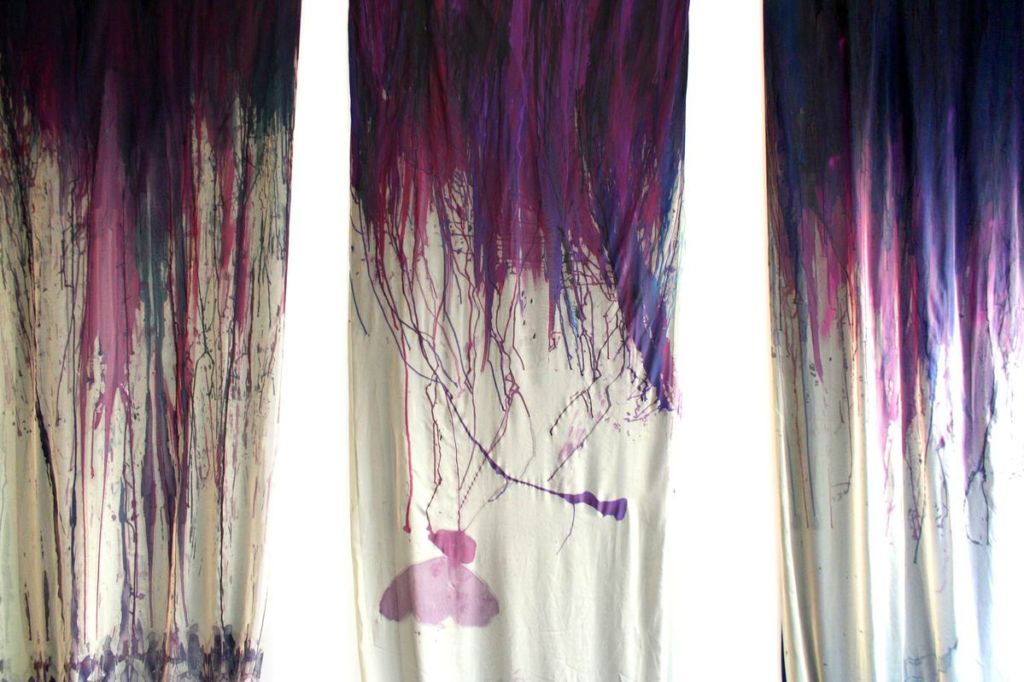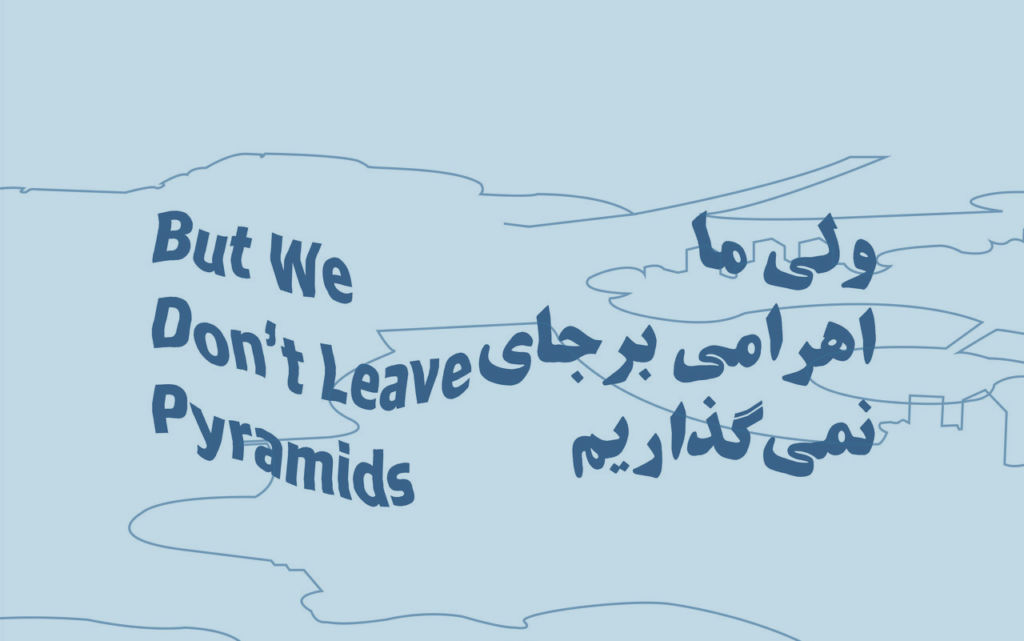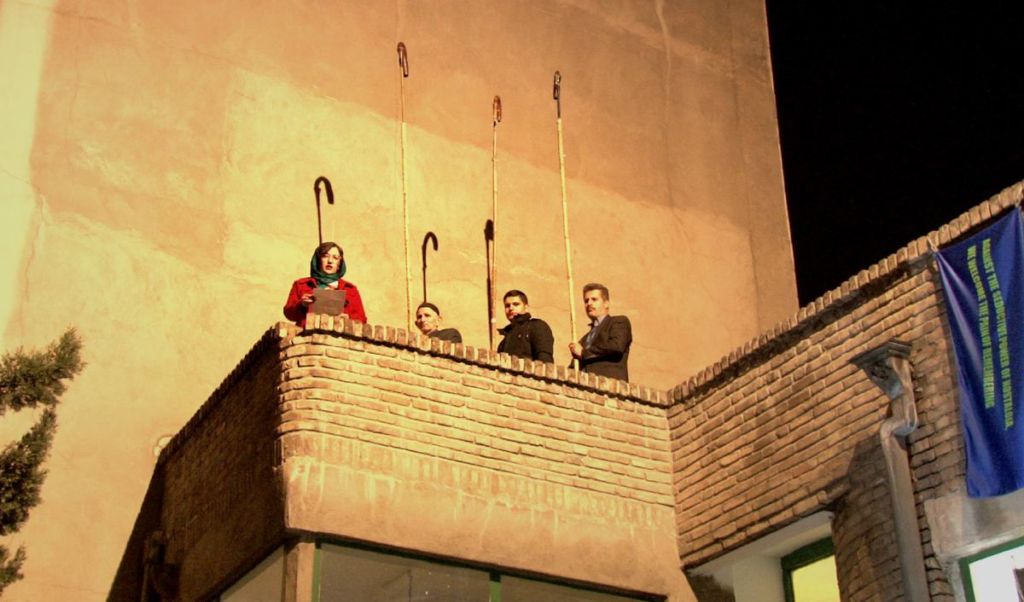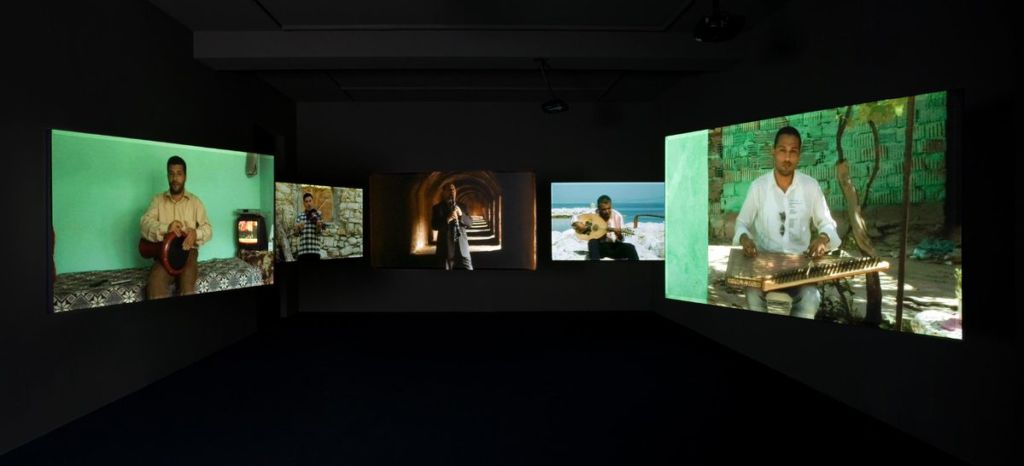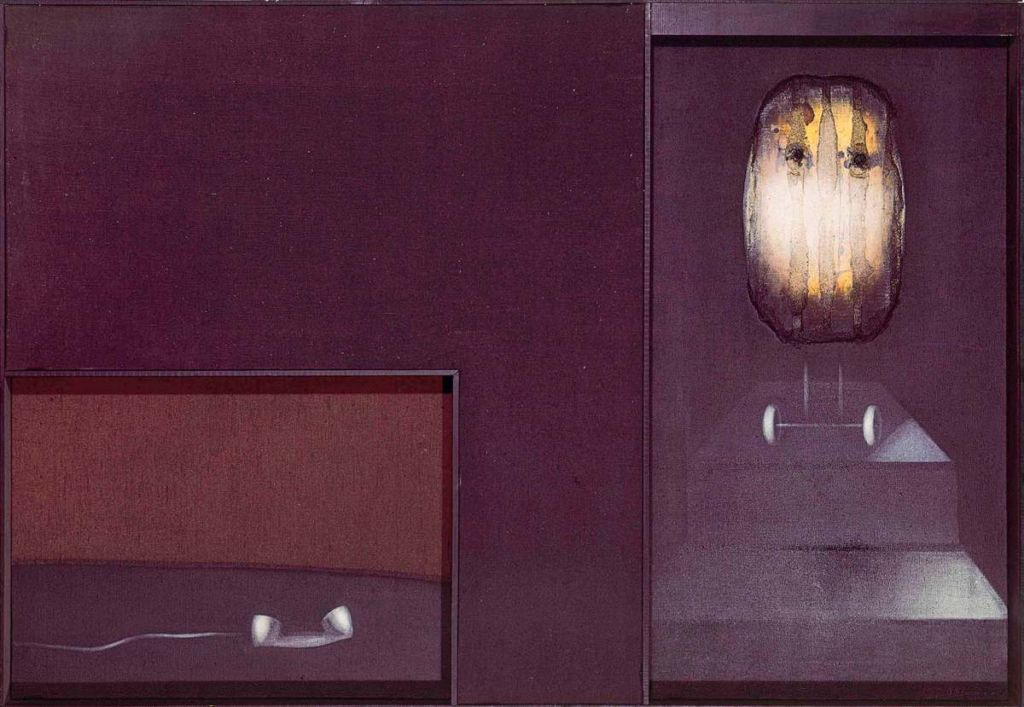In a game of ethereal to and fro between Paris and Cairo, political archives and fantasy images, the artist Georgia René-Worms immerses herself in an investigation in which, through the haze of Negroni, subjective intuitions and urban drift, the tutelary figures of the artistic avant-garde and the feminist and emancipatory struggles of the mid-twentieth century in Egypt re-emerge.
Iman Mersal, “Respecting Marx” in These are not oranges, my love: selected poems. Translated from the Arabic by Khaled Mattawa (Sheep Meadow Press, 2008).
Injî Aflâtûn, Mudhâkirât, Koweit, Dâr So’ad al-Sabbâh, 1993.
Extract from the catalogue Art et liberté. Rupture, war and surrealism in Egypte (1938-1948) – Centre Pompidou 2016, first published in La Nouvelle Revue française on 1st February 1939
“Face aux menaces, Decathlon renonce pour le moment à la commercialisation d’un hijab de jogging” (Libération, 26.02.2019)
Geneviève Fraisse, “Le voile, le burkini et l’impureté de l’Histoire” (Libération 29.09.2019)
Didier Monciaud, “Les engagements d’Inji Efflatoun dans l’Égypte des années quarante: la radicalisation d’une jeune éduquée au croisement des questions nationale, femme et sociale”, (Cahiers d’histoire. Revue d’histoire critique, no 126, 1st January 2015)
The Girl and the Beast, Inji Efflatoun, 1941, oil on canvas, 70 x 55 cm
Note reproduced in Surrealism in Egypt: Modernism and the Art and Liberty Group by
Sam Bardaouil (IB Taurus, 2016).
Georges Henein, “A contre-cloison” (London Bulletin, n° 17, 15 June 1939).
Inji Efflatoun’s Memoirs (Sa’id Khayyal, Kuwait: al-Suad al-Sabah, 1993).
In Egypt, a husband can file an “obedience” order (ta`a) against his wife if she leaves the marital home without his permission. If a wife refuses to return to the “house of obedience” (bayt al-ta`a) and does not lodge an objection specifying the legal grounds on which she did not obey her husband within thirty days of receipt of the notice, she is deemed to be deviant (nashez) and is denied alimony in the event of divorce.
In January 1949, two Egyptian doctoral students in economics in Paris, Fou’ad Morsy and Isma’il Sabri ‘Abdallah, members of the French Communist Party and trained by the party, returned to Egypt and founded the Communist Party of Egypt, with the support of the French Communist Party and the Italian Communist Party. It is the smallest of the Egyptian Marxist organizations, the CPE al-Raya (the flag).
Betty LaDuke, Egyptian Painter Inji Efflatoun: The Merging of Art, Feminism, and Politics (National Women’s Studies Association Journal, n° 3, 1989).
Betty LaDuke, Egyptian Painter Inji Efflatoun: The Merging of Art, Feminism, and Politics (National Women’s Studies Association Journal, n° 3, 1989).
Betty LaDuke, Egyptian Painter Inji Efflatoun: The Merging of Art, Feminism, and Politics (National Women’s Studies Association Journal, n° 3, 1989).
On the photo found in my iPhone, the data shows it was taken on July 1, 2017.
It’s the middle of summer in the backyard of the Calusca-City Lights bookshop in Milan, near the archives collected by Primo Moroni, an extreme left-wing activist and author of The Golden Horde, an anthology on the revolutionary, creative, political and existential wave that emerged from the extreme left-wing movements in Italy in the 1960s and 1970s.
It’s hot, around 35° C; I’m sitting at a plastic garden table from a promotional set advertising Miko ice cream, with matching chairs and parasol. There’s a lot of noise, an inflatable pool has been set up in the middle of the yard and bikers are busy preparing for the concert scheduled later in the evening. V. is sitting a little further away, waiting for me.
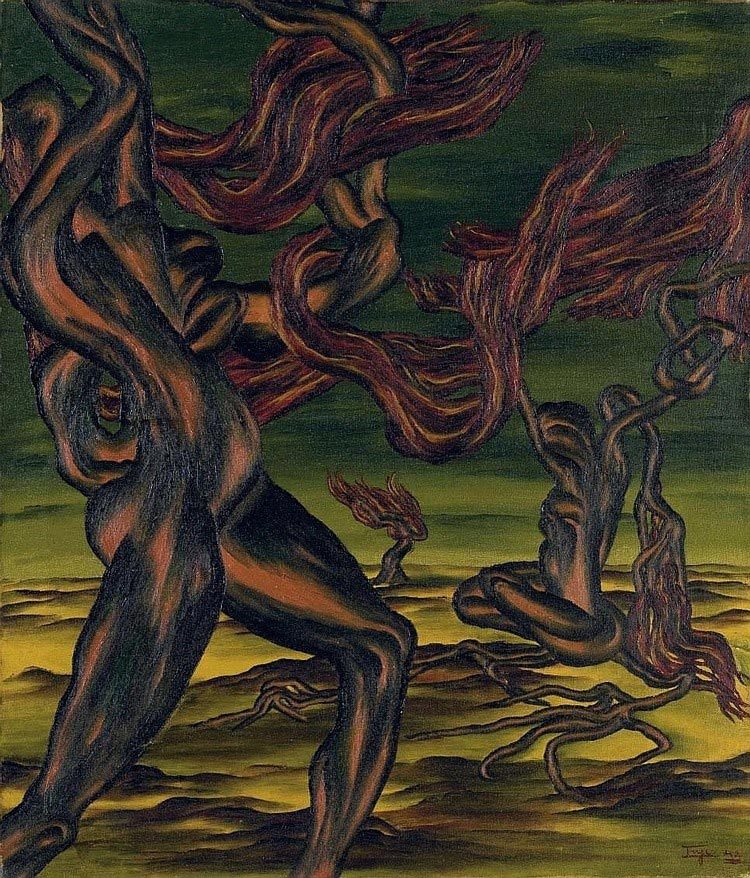
Inji Efflatoun, Composition Surrealiste, 1942, oil on canvas 70 x 60,2 cm, private collection.
In the article I’m photographing, there’s an image of a mixed group with the caption: Egyptian delegation to the Congrès International des Femmes, Paris, 1945, with Inji Efflatoun in centre.
The International Women’s Congress. Organised in Paris from 26 November to 1 December 1945 at the Maison de la Mutualité, it brought together 850 delegates from 41 nations with the fight against fascism, the well-being of children and the improvement of the status of women on the agenda.
In the summer of 2017, I was working on militant feminist groups and the Italian art scene of the 1960s and 1970s and looking for documents on the international convergences of extreme left-wing feminist struggles.
It’s the end of the afternoon. Since all the generator power is drained by the sound system, I can’t get my scanner to work. So I decide to hand the archive boxes back to the biker who was running the office that day and head off to drink some heavily laden Negronis with V.
The photo of the Egyptian delegation to the Congrès International des Femmes, Paris, 1945, with Inji Efflatoun in centre is left aside. At the time, the picture of me taken just afterwards, where I’m spraying my face under the jet of a fountain, without the slightest doubt as to the subjectivity of the gesture, strikes me as far more interesting…
[…]
Early February 2019, I leave Paris.
Flight Paris-Cairo
Departure 11:10 a.m., arrival 6:35 p.m.
The context of my stay in Cairo is well defined: the French Institute is launching its residency programme in partnership with the Townhouse Gallery, an independent non-profit Cairo art space created in 1998. The Townhouse Gallery aims to make art accessible to all groups of Egyptian society. The structure includes a theatre, exhibition space, art library, artists’ workshops and is located in downtown Cairo, in an area where craftsmen rub shoulders with car repairers, between Talaat Harb and Tahrir Square.
The internal situation of the Townhouse Gallery is complex: the director is no longer there, banned from Egyptian territory. Four years earlier, the building that housed the art centre’s offices and workshops had been partially demolished by the government and the gallery’s main exhibition space was closed by censorship and the tax authorities following a wave of repression of political dissidents.
[…]
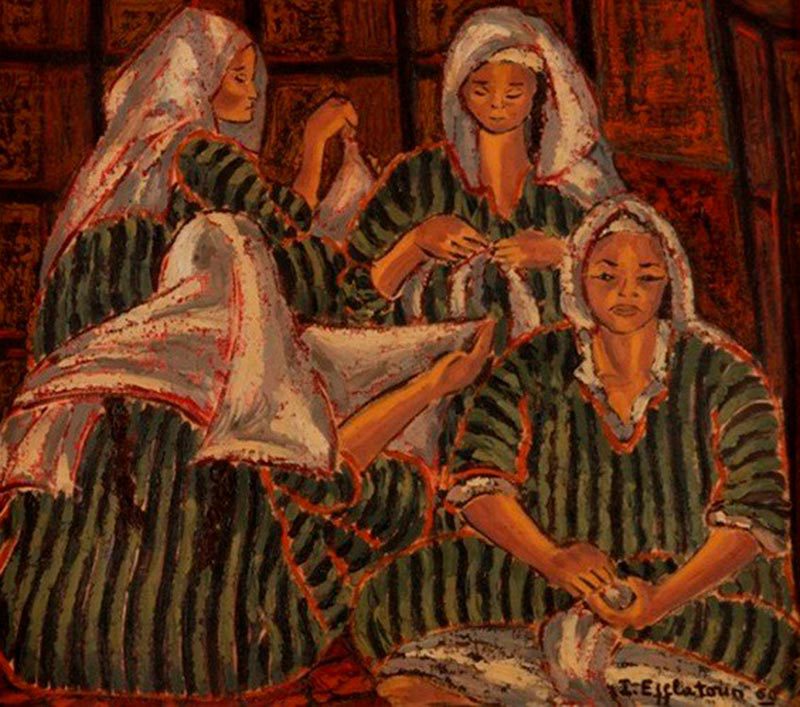
Inji Efflatoun, Dans la prison des femmes, ca 1960, oil on panel 58 x 52 cm, private collection.
I’m not here to visit the city, but to let it into me, to accept losing a little of my identity to make way for something else, without really knowing how to get out of it once I’ve digested it. To envisage an enzymatic invasion of myself, to be synthesized by the city. To take a return journey like being absorbed, ingested and digested from mouth to stomach, throwing yourself into a city that you hope will be cannibalistic.
Shortly before my landing, around 6 p.m., the plane passes through a dense layer of cloud that is completely black. There’s the city viewed as if through the eye of a camera with a filter that blurs into smog and neon lights. Meanwhile, I read the Egyptian poet Iman Mersal:
Facing bright storefronts
flourishing with panties
I cannot stop myself
from thinking about Marx.
Respecting Marx,
is the only thing all those who loved me shared
and I have allowed them all, in varying degrees,
to claw at the cotton dolls
hidden in my body.
Marx
Karl Marx
I will never forgive him1.
[…]
I’ve already been in Cairo for a few weeks and Marx is everywhere in my imagination, but nowhere in the city. Despite all the Negroni I’ve drunk in the last two years, I do know that Inji Efflatoun, the woman in the centre of the photo of the Egyptian delegation to the International Women’s Congress, Paris, 1945 was a feminist artist and activist.
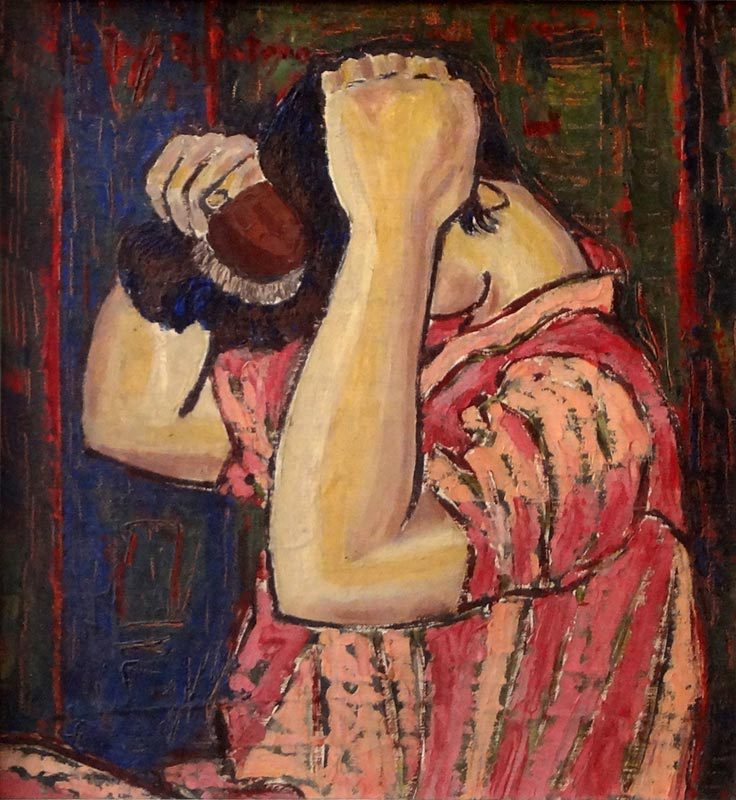
Inji Efflatoun, fille se peignant les cheveux, oil on canvas, ca 1950, 35 x 33 cm, private collection.
Born in 1924, she came from a Turkish-Circassian family. In the year of her birth, her mother, Salha Efflatoun, aged 19, decided to leave her husband and the palace where they lived. She settled with her daughters on the island of Zamalek in the heart of Cairo. Salha Efflatoun bought a fashion boutique on credit. Inji and her sister Gulpérie, who later became a writer, were enrolled at the French Catholic school of the Sacred Heart and then at the French Lycée. The colonial context in Egypt at the time was still very much alive, the country was no longer under British protectorate and was recognized as an independent sovereign state in 1922, but the British influence and military presence persisted until 1954.
During her secondary school studies, Inji Efflatoun became aware of the social inequalities between the French-speaking bourgeoisie and the vibrant Egyptian art scene. It was in this cultural world where education was not dispensed in Arabic, which she protested against, that her political awareness was born. At the time, having expressed her desire to practice painting, she refused her mother’s proposal to go to Paris to study art.
It was not acceptable and rational for me to leave Egypt and go to the countries of the khawagat (foreigners) for several years, when I thought with all my heart about the long and painful process of Egyptianization that I had chosen for myself, for my personality, I who had only spoken French before and had lost eighteen years of my life in a society wrapped up in cellophane. Until I was seventeen, my language was French and when I started to mix with people, I couldn’t loosen the knot that bound my language! Me, cut off from the tree?2
It was 1940. Inji Efflatoun was 16 years old. Faced with her refusal to leave for Europe, her mother hired a private tutor. This man was Kamel El-Telmissany, a painter, writer and director. In 1938, he was one of the signatories of the founding manifesto of the Egyptian surrealist movement Art and Liberty, a collective text written mainly by the poet Georges Henein with whom Inji Efflatoun was later to work. The manifesto, entitled Vive l’art dégénéée (Long live degenerate art!)3, was a stance taken by part of the community of intellectuals, artists, writers, journalists and lawyers in the face of the rise of fascism and the direct attack on culture that was taking place in Europe:
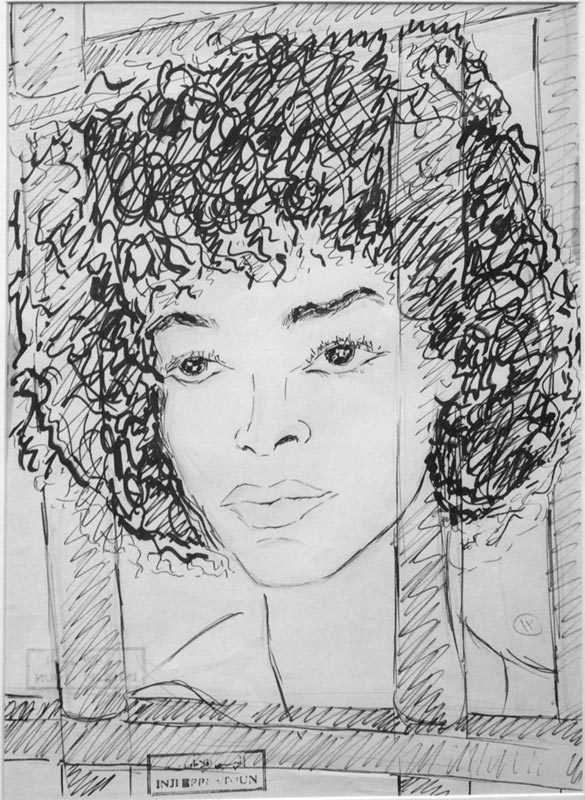
Inji Efflatoun, Prisonnière, 1960, ink on paper, 23 x 32 cm.
“We know with what hostility today’s society looks upon any literary or artistic creation, more or less directly threatening the intellectual disciplines and moral values on which its own duration and survival largely depend.
This hostility manifests itself today in totalitarian countries, in Hitler’s Germany in particular, by the most abject aggression against an art that high-ranking brutes promoted to the rank of omniscient arbitrators call “degenerate”.
From Cézanne to Picasso, everything that contemporary artistic genius has given of its best, everything that the modern artist has created that is freer and more humanly valid is insulted, proscribed. We hold in absolute contempt and consider as absurd and criminal those religious, racist and nationalist prejudices, to whose tyranny some individuals drunk with their provisional almighty power claim to enslave the destiny of the work of ar.
We refuse to see these regressive myths as anything other than true concentration camps of thought. Art, as a permanent spiritual and effective exchange in which the whole of humanity participates, can no longer experience such arbitrary limits.
In Vienna delivered to the barbarians, Renoir’s canvases are slashed, Freud’s works are burned in public squares. The most brilliant achievements of the great German artists such as Max Ernst, Paul Klee, Kokoschka, George Grosz, Kandinsky, Karl Hofer are blacklisted and must yield to the platitude of National Socialist art.
In Rome, a commission called “literary improvement” has just completed its dirty work by concluding that it is necessary to withdraw from circulation “all that is anti-Italian, anti-racist, immoral and depressive”.
Intellectuals, writers, artists! Let us take up the challenge together. We are in complete solidarity with this degenerate art. In it lie all the chances for the future. Let us work for its victory over the new Middle Ages that is rising in the heart of the West.
Cairo, 22 December 1938.”
As Europe sunk into fascism, the Middle East, which had itself experienced violent Western occupation, supported an endangered artistic community.
[…]
Cairo, sixty-nine years later.
Pollution gives the sky incredible colours: white tinted, transparent afternoons, purple sunsets. As for the sleepless nights, when the dogs howl louder than the muezzin, they are milky blue.
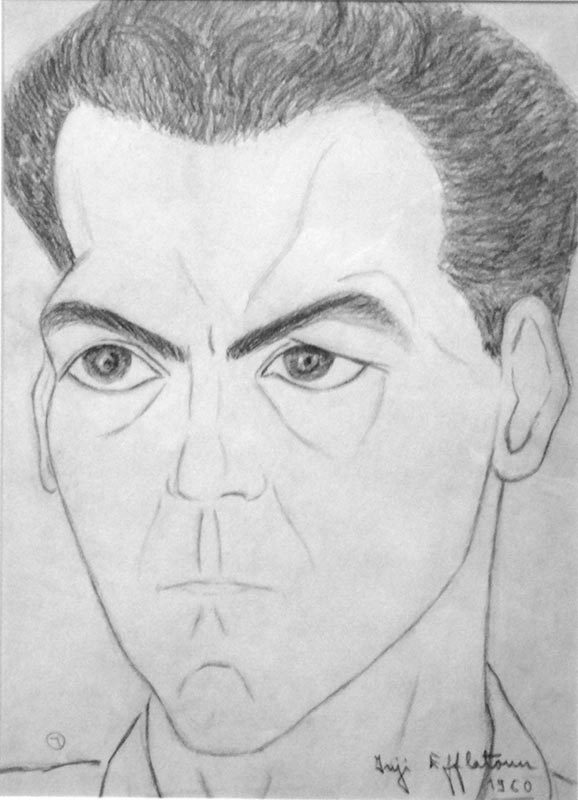
Inji Efflatoun, Prisonnier, 1960, ink on paper, 24 x 37 cm.
The city expands day by day. The authorities have announced that the new capital, 45 kilometres from Cairo, expected to be seven times the size of Paris, is well under way. The new city still has no name, but it is already understood that the first 17,000 hectares of Cairo’s new administrative centre should be completed within five years, as should the reconstruction of the Cathedral of Notre-Dame in Paris.
Meanwhile, the downtown streets are packed from noon to two o’clock in the morning. Around 10 pm, activity on Talaat Harb Street reaches its peak, the queues in front of El Abd ice-cream parlour spill out onto the road, the shops filled with counterfeit clothes and accessories are bustling, and in the distance, you can see the pink and green neon lights of the Koshary Abu Tarek restaurant. If you continue and turn left, you will come to Rue du Paradoxe. As in Iman Mersal’s poem, this street is lined with lingerie shops, each one crazier than the next.
The day after my arrival, after spending two hours looking for a supermarket, I came across the coolest lingerie shop window I’ve ever seen, a mix between the aesthetics of a BDSM club (Bondage and Discipline, Domination and Submission, Sadism and Masochism) and Christmas decorations. You wonder if Santa’s head resting on the plastic model’s pussy, kneeling and handcuffed in a fishnet suit, is part of the decor or part of the outfit… In the midst of Christmas garlands and baubles, there are G-strings with glitter and sequins and, a model never seen elsewhere, the two-tone Lurex G-string with three front holes… all mixed up in a jumble of women’s and children’s pyjamas. As I try on a few models, an alert comes up on my phone: Paris is deep in a discriminatory debate, the political scene is inflamed with the announcement of Decathlon marketing a jogging hijab. From the centre to the extreme right, people are protesting against the sale of a garment which, as the Minister of Sport says, “promotes sport for all in a logic of progress, inclusion, respect for others.”4
This dark new outcry recalls the summer of 2016 when the arrival of the burkini on the beaches of France put the focus of attention back on the simple gesture of veiling, unveiling, covering and revealing the female body. In September, Geneviève Fraisse published a text placing this purely political debate in a broader historical timeframe.
What is happening, at this moment in Western history, and in post-colonial history, is that emancipation, long thought of in terms of citizenship, education, access to professions, and therefore in terms of what makes humans similar, all humans, is becoming an issue linked to the body in its empirical difference, a project of emancipation. There has been, and still is, the issue of controlling reproduction, and there is also the issue of sexual identities, which are obviously multiple. From now on, we recognize the issue of bodies historicized by religion and geopolitics.5
It is well known that throughout its colonial history France has always been obsessed with the veil. At the end of the 1950s, a poster campaign in favour of “unveiling” was launched in Algeria by the psychological section of the army. On 13 May 1958 in Algiers, Place du Gouvernement, Muslim women were invited to burn their veils, under the “matronage” of the wives of Generals Salan and Massu. The ceremony carried a meaning: to demonstrate the “power” of the colonial forces in the emancipation of women.
I regularly watch Possession, a 1981 film directed by Andrzej Żuławski. The reason for this obsession is simple: I’ve never managed to find the blue dress worn by the character of Anna, played by Isabelle Adjani. In the Uber on the way to a tailor’s shop in Garden City with the intention of having the same dress made, I read a text by Didier Monciaud: “Inji Efflatoun’s commitments in Egypt in the 1940s: the radicalisation of a young educated woman at the crossroads of national, feminine and social issues”6, I came across a sentence that made me laugh out loud. The author recounts that Inji Efflatoun felt guilty because of her rich wardrobe, as most of her classmates were not from the same social background. A certain hostile press presented her as “the communist who owns forty dresses”. The analogy between Possession and Efflatoun immediately triggered a train of thought in my mind.
A few days earlier, I had tried to visit Amir Taz Palace where part of the artist’s studio and more than a hundred paintings are supposed to be kept. But the palace was closed for renovation… I wanted to see The Girl and the Beast7 because the passage from Possession where we understand that Anna’s mysterious lover is not human strangely brings this painting to my mind… The Girl and the Beast was first exhibited in May 1942 at the third independent art exhibition organized by the group Art and Liberty at the Egyptian Stock Exchange. Inji Efflatoun was 18 years old.
The journalist Étienne Meriel, in his note on the participating artists, wrote: “We will not easily forget this nocturnal cavalcade in a land of horror among the blue trees of Prussia.”8 What the journalist doesn’t say is that the two main characters in the painting are a flying chimera with a bird’s head wearing a large cape and, perched on the mountain, a young woman on the run, as if possessed, mummified in a midnight blue satin dress, revealing half her naked body. The picture later became part of a series of paintings illustrating Georges Henein’s poem “À contre-cloison”, the end of the poem resonating strangely with the events to come:
unless, however, the ashes become flame again, the blood becomes heart, darkness consciousness, consciousness conquest and man revolution9.
After the exhibition, Efflatoun continued to paint for a while, but she was mainly taken up with her activist activities. The artist remained close to the values of Art and Liberty, which were those of transnational solidarity. Again, according to Didier Monciaud “in 1944-1945 she participated in the launch of the League of Young Women of Universities and Institutes (Râbitat Fatayat al-gâmi’a wa al-ma’âhid). The League advocated an anti-colonial left-wing orientation, the specific interests of female students and graduates, and equality between men and women”. In 1945, she went to Paris for the International Women’s Congress. On the Egyptian scene as well as abroad, she appeared as a figure of feminist and communist engagement. She gave up painting to devote herself completely to her political activities but continued for a while to teach drawing at the French Lycée in Cairo in order to be financially independent. She soon gave up this job to become fully involved in politics. The following years were marked by the writing of two important books: Quatre-vingts millions de femmes avec nous (Eighty Million Women with Us) in 1948 and Nous les femmes égyptiennes (We Egyptian Women) in 1949 defending liberation from colonial oppression and the non-subjection of women to patriarchal power.
In her Memoirs10, Efflatoun denounces “the call for the return of women to the home, the defence of polygamy, the right of the man to repudiation and adultery (zinâ), the right to strike his wife, and the issue of authority.” “Permanent dependence on the man” can only be thwarted by the education of the woman (p. 6). Only economic independence will provide “total power in the choice of life partner” (p. 8). For the author, the family is weakened by polygamy (p. 10), the confinement of women to the home (p. 11) and repudiation. She stigmatizes adultery (zinâ) (p. 14-22) and the matriarchal reality of Egyptian law (p. 16). She defends the right to choose one’s husband (shariah), the right to education and financial independence, and the need for reforms: prohibition of polygamy, limitation of repudiation, establishment of equality with the right to divorce and the abolition of Al-Tâ’a.11
Efflatoun maintained her political commitment throughout the 1950s. She made her affiliation to the communist movements official by joining the al-Raya Party12. When Nasser gained power in 1956 the situation became more complex for the communists. Activists were arrested or silenced, such as Duriyya Shafiq, who was placed under house arrest. Inji Efflatoun was arrested in 1959 and remained in prison until 1963.
The most difficult aspect of the imprisonment was the uncertainty: “we were neither condemned to die nor given an official time sentence. We didn’t know how long we would stay… a whole lifetime, or to be liberated tomorrow. You live on your nerves. I said to my comrade prisoners, ‘Don’t always think about liberation”. Efflatoun was emotionally prepared for this experience; as she said, “I knew from the first day I became militant, I risked prison.” She described prison as “a small village where all the vices of society are packed together, the prostitutes, hashish dealers, thieves, and the condemned.13
During the first two years, Efflatoun resumed painting and depicted scenes of daily life in the women’s prison, collective scenes of prisoners crammed into dormitories or portraits of prisoners alone behind bars. Gulpérie regularly came to bring her materials equipment.: “My sister, before she too was imprisoned, came to give me good paints. I then secretly bribed the guards who rolled the unstretched canvases (…) around their bodies to take them out… I was afraid, because if they caught the guard with my painting, they would take away from me the right to paint.”14
In early 1963, Inji Efflatoun only painted still lifes and landscapes until her release in July of that year. The release came suddenly on the orders of President Nasser, who put an end to the incarceration of political prisoners and closed the women’s detention camps. Efflatoun explains:
When I came out of prison, I became much more human. Before, I was militant and a little dogmatic. When I came out of prison, I became more open to people, to life. Before, I didn’t compromise. Now if I see someone’s weakness, I can accept it.15
[…]
Here, it’s 3:45 pm, it’s 33°C, the sun is beating down on the balcony, the muezzin calls out. For a week now, the city has been buzzing, we go from festival to festival, Coptic festivals, Christian festivals, in a few days Ramadan will begin. Mahmoud Bassiouny street where I live, which starts from Talaat Harb and goes to the Museum of Cairo, is filled with military trucks. In the evening, tanks and police vans are parked in Talaat Harb square. The country has just voted a constitutional reform allowing President Sissi to remain in power until 2030 and to strengthen the role of the army. Last Saturday, I spent a long time with Rawia, an artist and translator who regularly comes to Townhouse to run writing workshops. We sat on a bench in the middle of the empty exhibition space. Rawia told me about her daughter Yara Sallam, a human rights activist. After being sentenced to three years in prison in 2014 for violating the law against demonstrations in Egypt, she was released in October 2015. Since then, she has been leading the project Even the Finest of Warriors on the history of women who have fought or are still fighting for human rights in the Middle East after the 2011 revolutions, and the psychological and physical impact of their involvement. Yara Sallam puts the personal dimension at the heart of her investigative work. She talks about women who are still active or others who, exhausted, have given up the fight. As with Inji Efflatoun, resilience is the word that comes to mind when I think of these Finest of Warriors. Yara Sallam talks about warriors, accepting that “even the finest of warriors… get exhausted and let their guard down.”
Hervé Guibert, Lettres d’Égypt
I feel as if I had deserted Paris like a battlefield, having filled it with bombs of which I did not have the courage to wait for the echo of the explosions […] I feel as if I had been arrested, like a culprit, and transferred to this foreign country, like a hostage who has to go through a series of trials, the pyramid trap, sunstroke, the desert, frantic flies, unworthy exchanges of words and money, before being able to go back to square one.
Cover: Egyptian delegation to the Congrès International des Femmes, Paris, 1945, with Inji Efflatoun in centre © MoME – Bibliotheca Alexandrina
Translation by Angela Kent
[rl_gallery id=”24730″]

